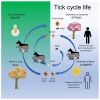Recent Advances in the Immunologic Method Applied to Tick-Borne Diseases in Brazil
- PMID: 36014992
- PMCID: PMC9414916
- DOI: 10.3390/pathogens11080870
Recent Advances in the Immunologic Method Applied to Tick-Borne Diseases in Brazil
Abstract
Zoonotic-origin infectious diseases are one of the major concerns of human and veterinary health systems. Ticks, as vectors of several zoonotic diseases, are ranked second only to mosquitoes as vectors. Many ticks' transmitted infections are still endemic in the Americas, Europe, and Africa and represent approximately 17% of their infectious diseases population. Although our scientific capacity to identify and diagnose diseases is increasing, it remains a challenge in the case of tick-borne conditions. For example, in 2017, 160 cases of the Brazilian Spotted Fever (BSF, a tick-borne illness) were confirmed, alarming the notifiable diseases information system. Conversely, Brazilian borreliosis and ehrlichiosis do not require notification. Still, an increasing number of cases in humans and dogs have been reported in southeast and northeastern Brazil. Immunological methods applied to human and dog tick-borne diseases (TBD) show low sensitivity and specificity, cross-reactions, and false IgM positivity. Thus, the diagnosis and management of TBD are hampered by the personal tools and indirect markers used. Therefore, specific and rapid methods urgently need to be developed to diagnose the various types of tick-borne bacterial diseases. This review presents a brief historical perspective on the evolution of serological assays and recent advances in diagnostic tests for TBD (ehrlichiosis, BSF, and borreliosis) in humans and dogs, mainly applied in Brazil. Additionally, this review covers the emerging technologies available in diagnosing TBD, including biosensors, and discusses their potential for future use as gold standards in diagnosing these diseases.
Keywords: Brazilian Spotted Fever; Lyme disease; biosensors; borreliosis; ehrlichiosis; immunologic diagnosis; serological diagnosis; tick-borne diseases.
Conflict of interest statement
The authors declare no conflict of interest.
Figures



Similar articles
-
[Tick borne zoonosis: selected clinical and diagnostic aspects].Parassitologia. 2004 Jun;46(1-2):109-13. Parassitologia. 2004. PMID: 15305697 Review. Italian.
-
Patterns Testing for Tick-Borne Diseases and Implications for Surveillance in the Southeastern US.JAMA Netw Open. 2022 May 2;5(5):e2212334. doi: 10.1001/jamanetworkopen.2022.12334. JAMA Netw Open. 2022. PMID: 35576005 Free PMC article.
-
Searching for Lyme borreliosis in Australia: results of a canine sentinel study.Parasit Vectors. 2017 Mar 13;10(1):114. doi: 10.1186/s13071-017-2058-z. Parasit Vectors. 2017. PMID: 28285585 Free PMC article.
-
Knowledge, attitudes, and practices of Illinois medical professionals related to ticks and tick-borne disease.One Health. 2022 Jul 31;15:100424. doi: 10.1016/j.onehlt.2022.100424. eCollection 2022 Dec. One Health. 2022. PMID: 36277108 Free PMC article.
-
Ticks and tick-borne diseases in Oklahoma.J Okla State Med Assoc. 1998 Nov;91(8):438-45. J Okla State Med Assoc. 1998. PMID: 9828526 Review.
Cited by
-
Lyme disease in companion animals: an updated state-of-art and current situation in Portugal.Vet Res Commun. 2024 Dec;48(6):3551-3561. doi: 10.1007/s11259-024-10532-8. Epub 2024 Sep 11. Vet Res Commun. 2024. PMID: 39259416 Free PMC article. Review.
-
Hard Ticks as Vectors: The Emerging Threat of Tick-Borne Diseases in India.Pathogens. 2024 Jul 2;13(7):556. doi: 10.3390/pathogens13070556. Pathogens. 2024. PMID: 39057783 Free PMC article. Review.
-
Diversity of Anaplasmataceae Transmitted by Ticks (Ixodidae) and the First Molecular Evidence of Anaplasma phagocytophilum and Candidatus Anaplasma boleense in Paraguay.Microorganisms. 2024 Sep 14;12(9):1893. doi: 10.3390/microorganisms12091893. Microorganisms. 2024. PMID: 39338567 Free PMC article.
References
-
- World Health Organization Vector-Born Diseases. [(accessed on 1 September 2021)]. Available online: https://www.who.int/news-room/fact-sheets/detail/vector-borne-diseases.
Publication types
Grants and funding
LinkOut - more resources
Full Text Sources

